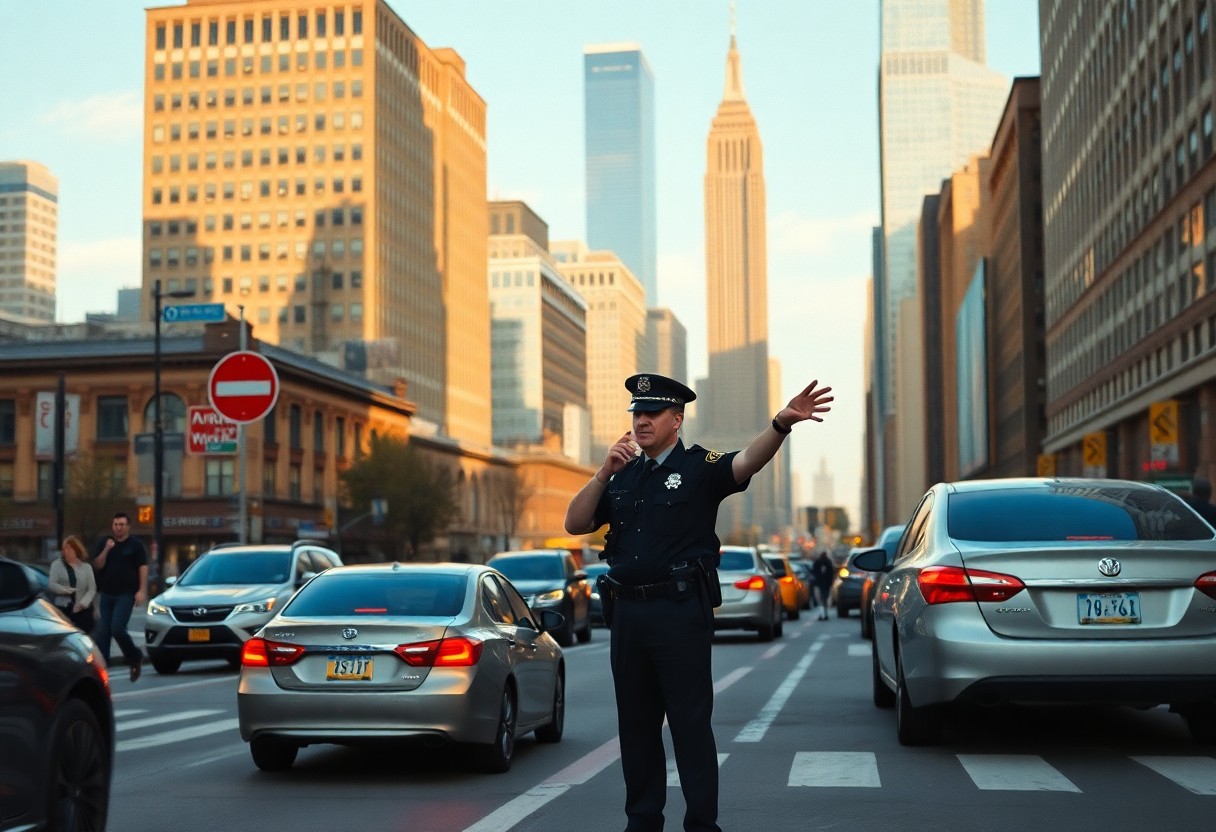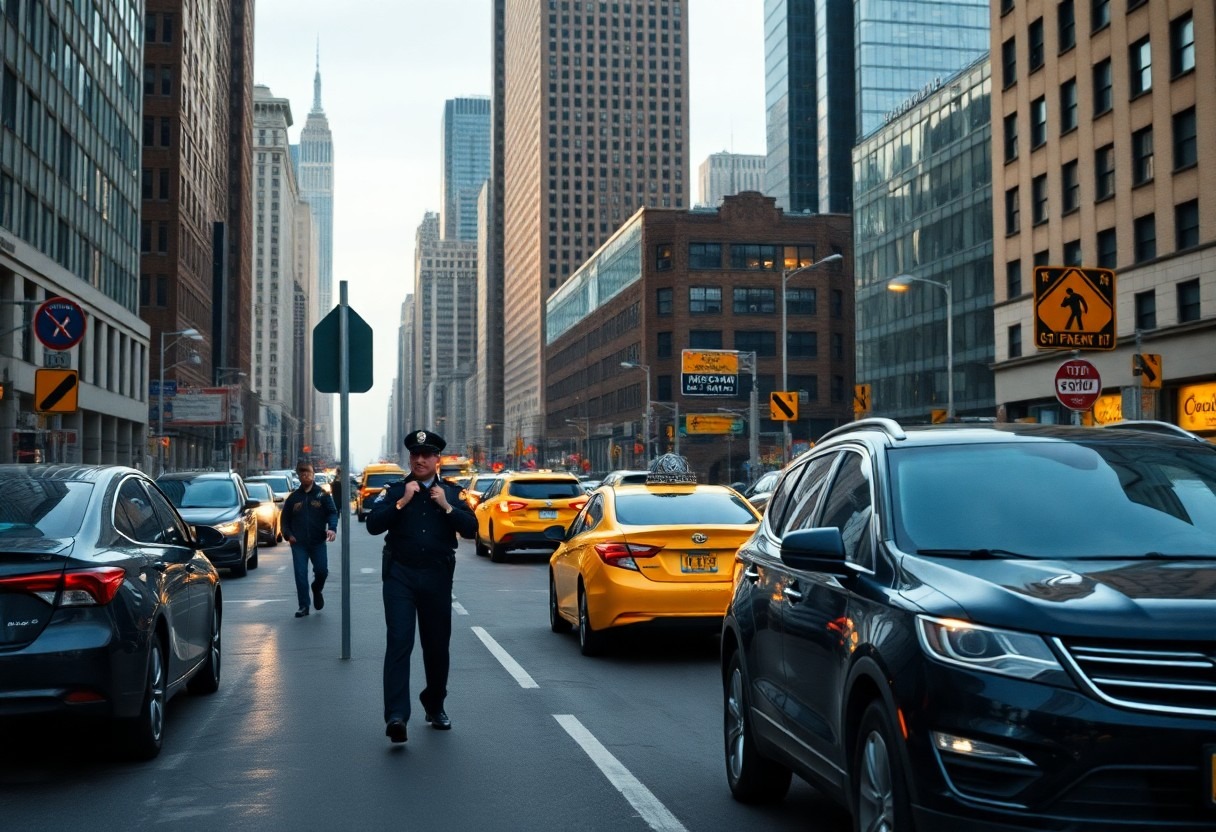To successfully navigate the bustling streets of New York City, it's essential to understand the unique challenges associated with driving in such a vibrant and dynamic metropolis. Operating a vehicle in the Empire State requires adapting to heavy traffic conditions while strictly following traffic regulations that aim to safeguard all road users. It’s crucial to familiarize yourself with specific local driving laws, which include the 25 mph speed limit in urban areas and the absolute prohibition of using handheld devices while driving. Whether you’re exploring the iconic grid layout of Manhattan or traveling through the scenic upstate regions, a solid grasp of New York’s driving laws will empower you to navigate its varied roadways with confidence, ensuring that you remain safe on New York’s bustling streets.
Essential Driving Regulations for Safety in New York
In New York, following fundamental driving regulations is vital for ensuring safety on the road. Drivers must always drive on the right side of the road, maintaining a safe distance from the vehicle ahead and using turn signals when changing lanes. Additionally, it is imperative that your vehicle is equipped with functional headlights, taillights, and brake lights, which not only enhance visibility but also communicate your intentions to other drivers. Remember, seat belts are mandatory for all passengers, and children under eight years old must be secured in appropriate restraint systems to maximize safety. These regulations not only promote your personal safety but also contribute to an overall culture of responsibility and awareness among all road users, leading to a safer driving environment for everyone.
Comprehending Speed Limits and Traffic Signal Compliance
Speed limits in New York are not uniform and can vary significantly based on specific locations. The 25 mph speed limit is the standard in New York City unless otherwise indicated by posted signs, while highways typically permit speeds ranging from 55 to 65 mph. It is imperative to come to a complete stop at red lights and stop signs since this is a critical component of safe driving practices. In NYC, right turns on red are prohibited unless there is a sign specifically allowing it. Moreover, intersections and school zones are closely monitored by traffic cameras, which reinforces the necessity of remaining vigilant and adhering to all traffic signals at all times.
Yielding to Pedestrians and Recognizing Right-of-Way Laws
Beyond standard traffic laws, it is crucial to always yield to pedestrians in crosswalks, regardless of whether they are marked or unmarked. This responsibility includes stopping for school buses displaying flashing red lights and yielding to emergency vehicles. Failing to yield to pedestrians can result in hefty fines and points on your license, which can adversely affect your driving record. Exercising heightened caution in school zones and residential areas is essential due to the increased volume of pedestrian traffic. Remember that pedestrians have the right-of-way when crossing with the signal, and you must remain stopped until they have fully crossed the street. Blocking crosswalks or intersections, even momentarily, should be avoided to ensure the safety of all road users.
Furthermore, it’s important to acknowledge that the responsibility for pedestrian safety lies heavily on drivers, especially in areas with high foot traffic. This necessitates being particularly attentive during peak hours when children are arriving or leaving school. Always be on the lookout for pedestrians who may unexpectedly enter the roadway, and be prepared to stop at a moment's notice. By prioritizing pedestrian safety, you contribute to creating a more secure driving environment for everyone involved.
Ensuring Vehicle Condition and Compliance with Regulations
Before embarking on New York’s busy streets, it is essential that your vehicle meets specific state requirements to ensure safety and compliance. Regular vehicle maintenance is crucial, which includes verifying that your car has functional headlights, properly inflated tires, and well-maintained brakes. The New York Department of Motor Vehicles (DMV) mandates annual safety inspections for all registered vehicles to ensure compliance with safety standards, which is vital for the well-being of all drivers and passengers on the road. Staying proactive with these requirements not only helps you avoid penalties but also significantly enhances your vehicle's performance and reliability. This diligence fosters a safer driving experience in the long run.

Understanding Registration and Insurance Obligations for Drivers
Every legal vehicle operating in New York must possess the appropriate documentation, which includes maintaining minimum liability insurance coverage of $25,000/$50,000 for bodily injury and $10,000 for property damage. Keeping your vehicle registration current is also crucial, as you must display valid inspection stickers on your windshield as proof of compliance. Failure to meet these requirements can result in significant fines and even license suspension, complicating your ability to drive legally. By ensuring that all documentation is in order, you protect yourself from potential legal complications and create a smoother driving experience throughout the state.
Meeting New York's Safety Equipment Standards for Vehicles
In addition to registration, ensuring your vehicle complies with New York’s safety equipment standards is vital for legal operation. Your vehicle must be equipped with functioning headlights, brake lights, turn signals, and windshield wipers to enhance visibility and facilitate clear communication with other drivers on the road. The state also mandates that vehicles include functional seat belts, mirrors, and a horn. These safety measures are essential for protecting your safety and that of others while driving. Moreover, New York’s equipment regulations extend beyond basic requirements, demanding that vehicles maintain proper emission standards and undergo regular smog checks to mitigate environmental impact. Regularly inspecting these components will help ensure that your vehicle is both safe and compliant.
Additionally, it is crucial to routinely assess your vehicle for adequate tire tread depth, properly functioning brakes, and operational defrosters to prepare for varying weather conditions. Keeping emergency equipment such as hazard lights and reflectors readily accessible is also vital for unexpected situations. By adhering to these safety equipment standards, you not only comply with the law but also contribute to a safer driving environment for all road users.

Successfully Navigating Special Zones and Local Driving Restrictions
When driving in New York, it’s essential to exercise extra caution and comply with specific local regulations in designated zones. Certain areas, such as school zones, construction zones, and residential neighborhoods, have unique rules that must be strictly adhered to. Violating regulations in these areas can result in substantial fines, ranging from $90 to $600, depending on the severity of the violation. Understanding and respecting these local rules is crucial for ensuring the safety of all road users and fostering a harmonious driving environment in the city.
Exercising Caution in School and Work Zones
School and work zones are among the most critical areas that demand your full attention while driving. In these zones, you must reduce your speed to 15-20 mph during school hours, ensuring the safety of vulnerable pedestrians, particularly children. In work zones, it is imperative to adhere to posted speed limits and maintain a safe distance from construction workers at all times. Penalties for speeding in these areas are often doubled, highlighting the importance of heightened safety awareness. By staying vigilant and following the rules in these zones, you play a significant role in protecting those who are most at risk.
Understanding Essential Parking Regulations to Avoid Fines
Grasping the vital parking rules in New York is crucial to avoid unnecessary fines and inconveniences. Alternate-side parking regulations are enforced in most areas, and it is imperative to carefully observe posted signs indicating specific days and times for parking restrictions. Metered parking zones are prevalent throughout the city, with rates varying by location and time of day, so it’s essential to always check the meter before leaving your vehicle. Additionally, you must adhere to strict enforcement of fire hydrant clearance (maintaining a minimum of 15 feet) and avoid no-standing zones near intersections.
Moreover, being aware of residential permit requirements in certain neighborhoods is critical to prevent parking violations. Failure to comply with these regulations can lead to tickets ranging from $65 to $115, and your vehicle may be towed if you block essential services or create safety hazards. Staying informed and compliant with parking regulations will not only save you from costly fines but also ensure a smoother experience while driving in New York City.
Comprehending Driver’s License Requirements for Legal Driving in New York
Having a valid driver’s license is essential for legal driving in New York. To operate a vehicle, you must be at least 16 years old and possess either a New York State driver’s license or a valid out-of-state license. For first-time drivers, completing a state-approved driver education course and successfully passing both written and road tests is mandatory. These requirements are designed to ensure that all drivers are adequately prepared to navigate New York’s complex roadways, enhancing overall safety.
Exploring Various Classifications of New York Driver’s Licenses
One of the most critical aspects of driving in New York is understanding the different license classifications. Class D is the standard license for passenger vehicles, while commercial driver’s licenses (CDL) are categorized from Class A to Class C, each with specific privileges and restrictions regarding the types of vehicles you can legally operate. Knowing the differences in license classes is vital to ensure you possess the proper credentials for the vehicle you intend to drive, thus avoiding legal complications and contributing to overall road safety.
Guidelines for Out-of-State Licenses for New Residents
If you hold an out-of-state license, it remains valid for up to 30 days after establishing residency in New York. As a tourist or temporary resident, you are legally allowed to drive with your home state’s license. International visitors must possess a valid foreign license along with an International Driving Permit to drive legally in New York. Furthermore, specific rules apply to military personnel and their families, allowing them to maintain their home-state licenses while stationed in New York. If you become a permanent resident, you must exchange your out-of-state license within 30 days by visiting a DMV office and passing a written test to ensure compliance with state regulations and driving laws.
Implementing Effective Safety Measures for a Secure Driving Experience
For your safety on New York roads, adhering to strict traffic regulations and maintaining constant awareness of your surroundings is paramount. Your vehicle should be equipped with essential safety features, including functional headlights, taillights, turn signals, and properly inflated tires to ensure optimal performance. Regular vehicle maintenance is crucial for safe driving, especially in New York’s demanding traffic conditions. By prioritizing these safety measures, you can significantly reduce the risk of accidents and ensure a safer and more secure driving experience for yourself and others on the road.
Child Safety Requirements to Protect Young Passengers
To effectively safeguard young passengers, any child under eight years old must be secured in an appropriate child restraint system. Children under two years of age are required to ride in a rear-facing car seat, while those between the ages of two and four must use a forward-facing car seat. For children aged four to eight, booster seats are necessary to ensure their safety. Violations of these requirements can result in fines of up to $100 and three penalty points on your license. By enforcing these child safety measures, you contribute to the protection of our youngest and most vulnerable passengers on the road, ultimately fostering a safer driving environment.
Mandatory Seatbelt Use and Mobile Device Regulations for Drivers
To enhance the safety of you and your passengers, mandatory seatbelt use for all vehicle occupants is enforced in New York. It is essential to ensure that everyone in the vehicle is buckled up, regardless of their seating position. The use of handheld devices while driving is strictly prohibited, with fines ranging from $50 to $450 for violations, depending on whether it is a repeat offense. Remember, even a brief distraction can lead to severe consequences on New York roads, jeopardizing not only your safety but also that of others.
Your first violation of mobile device laws results in five driver violation points, and subsequent offenses may lead to license suspension. While hands-free devices are permitted, it’s advisable to minimize their use to maintain focused attention on the road. By adhering to these regulations, you not only protect yourself but also contribute to the overall safety of the driving environment in New York.

Awareness of Traffic Violations and Their Consequences
Navigating New York’s traffic laws necessitates your constant vigilance and attention to detail. The city enforces strict compliance with traffic regulations, with violations leading to severe consequences. Understanding these rules is not solely about avoiding fines; it is also critical for maintaining road safety for everyone on the road. Being aware of potential infractions can significantly reduce your risk of accidents and legal troubles while driving in this bustling city.
Identifying Common Traffic Infractions on New York Roads
On the streets of New York, some of the most frequently encountered violations include speeding (especially in school zones), running red lights, using mobile phones illegally, and making improper turns. The likelihood of enforcement is high, as the city utilizes both traditional police patrols and automated enforcement systems to monitor compliance. Recent statistics indicate that speed cameras alone issued over 4 million violations in 2022, underscoring the importance of adhering to speed limits and traffic signals to avoid penalties and maintain road safety.
Understanding Penalties, Fines, and Their Implications for Drivers
When it comes to penalties for traffic violations, first-time offenders may face fines ranging from $50 to $1,000, depending on the nature of the offense. The New York DMV operates on a point system, where accumulating 11 points within 18 months can lead to license suspension. Additionally, your insurance rates may significantly increase following any violations, impacting your financial standing. It’s important to recognize that New York employs a graduated penalty system, meaning that repeat offenses result in progressively severe consequences. Violations can remain on your driving record for up to four years, potentially affecting your insurance rates and driving privileges. The state’s zero-tolerance policy for DUI offenses can lead to immediate license suspension and mandatory court appearances, reinforcing the need for responsible driving practices.
Key Takeaways for Driving Safely in New York
Driving in New York requires your full attention and adherence to a wide array of specific regulations. Your safety, along with that of others, relies on following speed limits, yielding to pedestrians, and ensuring proper child restraints. You can find well-maintained vehicles that meet all safety requirements through RentaCar24.org, allowing you to navigate the city confidently. By staying informed about local traffic laws and keeping these essential guidelines in mind, you’ll be well-equipped to tackle the challenges of New York’s busy streets. Understanding and respecting these regulations will contribute to a smoother and safer driving experience throughout the Empire State.
The Article: Driving in New York: Essential Rules and Regulations for Safe Travel appeared first on https://rentacar24.org/
The Article Essential Rules and Regulations for Safe Driving in New York Was Found On https://limitsofstrategy.com



It’s interesting how the unique driving regulations in New York reflect the city’s overall pace and culture. The 25 mph speed limit feels surprisingly restrictive at first, but it makes sense given the sheer volume of pedestrians and cyclists sharing the road. I wonder, though, how effective these regulations are in practice. With so much congestion, many drivers seem to push the limits—especially in rush hour. It raises the question of whether stricter enforcement could actually enhance safety or if it would just lead to more frustration among drivers.
You bring up some great points about New York’s driving regulations and how they mirror the city’s fast-paced culture. The 25 mph speed limit, while it can feel constraining, really does prioritize the safety of pedestrians and cyclists—something I think many other cities could learn from. It’s a delicate balance between moving traffic and ensuring that everyone can coexist safely on the roads.
You’ve hit on a key point about the balance between regulation and practicality in a bustling city like New York. The low speed limit is often a tough adjustment for drivers, especially when you’re stuck in traffic and a bit of extra speed could feel like a relief.
“That’s a great point! If you’re curious about how these regulations affect not just safety but also the overall driving experience in NYC, check out our in-depth exploration of urban driving dynamics here.”
https://cnisclub.org/quillbot
You bring up an interesting point about the 25 mph speed limit in New York. It definitely feels restrictive when you first experience it, especially if you’re used to faster-paced driving. But I think it’s a testament to how the city prioritizes safety and the well-being of its residents. The mix of pedestrians, cyclists, and vehicles creates a unique environment that arguably demands different rules than less populated places.
Speaking of unique driving regulations, I recently came across some insights on navigating the roads in Italy that really highlight how cultural differences shape driving experiences, much like in New York.
‘Driving in Italy: Essential Tips for Your Road Trip’
https://cnisclub.org/driving-in-italy-essential-tips-for-your-road-trip/.
You make a great point about how the 25 mph speed limit reflects New York’s commitment to safety amid its bustling environment. The mix of pedestrians, cyclists, and drivers really does create a unique urban dynamic. In a city where you might see a three-block stretch filled with people, having lower speed limits can indeed help reduce accidents and enhance the sense of community.
You make an interesting point about the 25 mph speed limit. It really does feel counterintuitive when you consider the bustling environment that defines New York. But when you think about how many people are walking or biking—especially in neighborhoods like Manhattan—the logic becomes clearer. It’s a matter of prioritizing safety over speed, which is essential in such a densely populated area.
You’ve touched on a vital aspect of urban life that often gets overlooked in discussions about transportation: the balance between speed and safety. In New York City, where vibrancy and chaos seem to dance hand in hand, it can be easy to feel frustrated by a speed limit that feels almost too low for such a dynamic environment. But as you mentioned, when you factor in the sheer volume of pedestrians and cyclists weaving through the streets, the rationale behind that limit begins to come into focus.
“Absolutely! Safety should always come first in a vibrant city like New York. For more insights on urban planning and pedestrian safety, check out this resource.”
https://cnisclub.org/octopus
You really nailed it with your thoughts on the 25 mph speed limit. It’s fascinating to see how a bustling metropolis like New York, often thought of as a place where speed and efficiency reign supreme, can still find room to prioritize safety. The sheer number of pedestrians and cyclists in neighborhoods like Manhattan makes a strong case for measures that protect everyone on the street.
You’ve beautifully captured the nuances of driving in New York City, and it really resonates with me. Having lived there for a few years, I can attest to the distinct blend of exhilaration and frustration that comes with being behind the wheel in such a bustling environment. The point about adapting to heavy traffic is so crucial. It often feels like the streets transform into a living organism, with every vehicle playing its part in the chaotic ballet of city life.
It’s interesting how the rhythm of driving in a city like New York creates a unique connection among all of us who navigate those streets. That feeling of exhilaration mixed with frustration really captures the essence of the experience. You’re right about the streets feeling like a living organism—every car, bus, and cyclist interacts in ways that can sometimes be baffling yet beautiful.